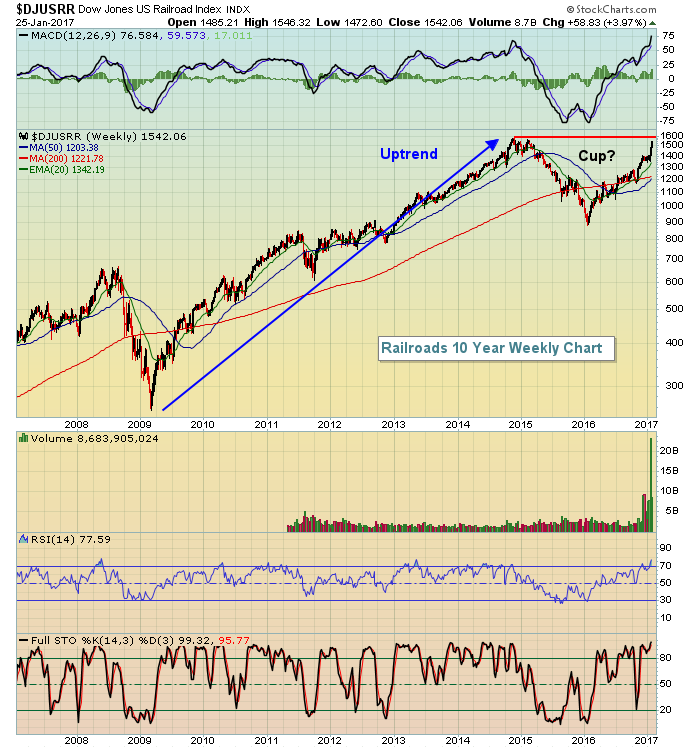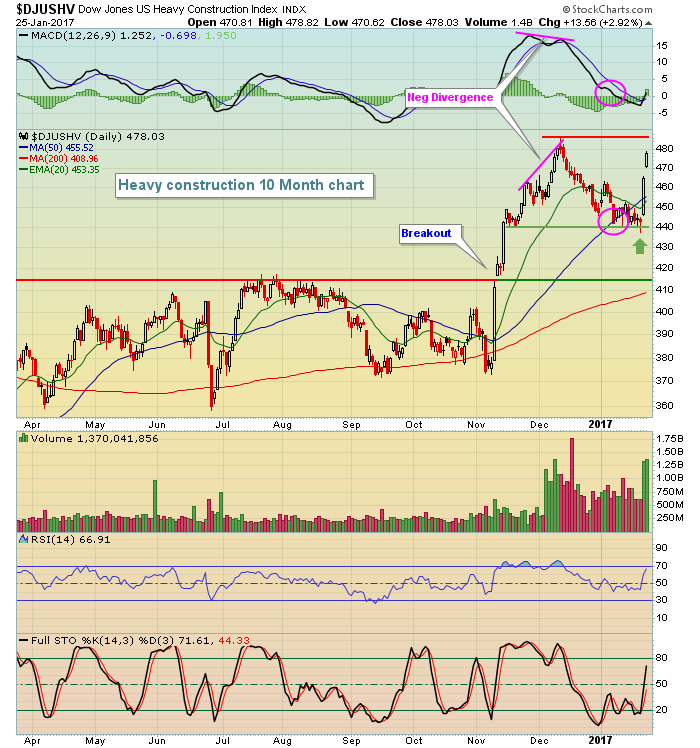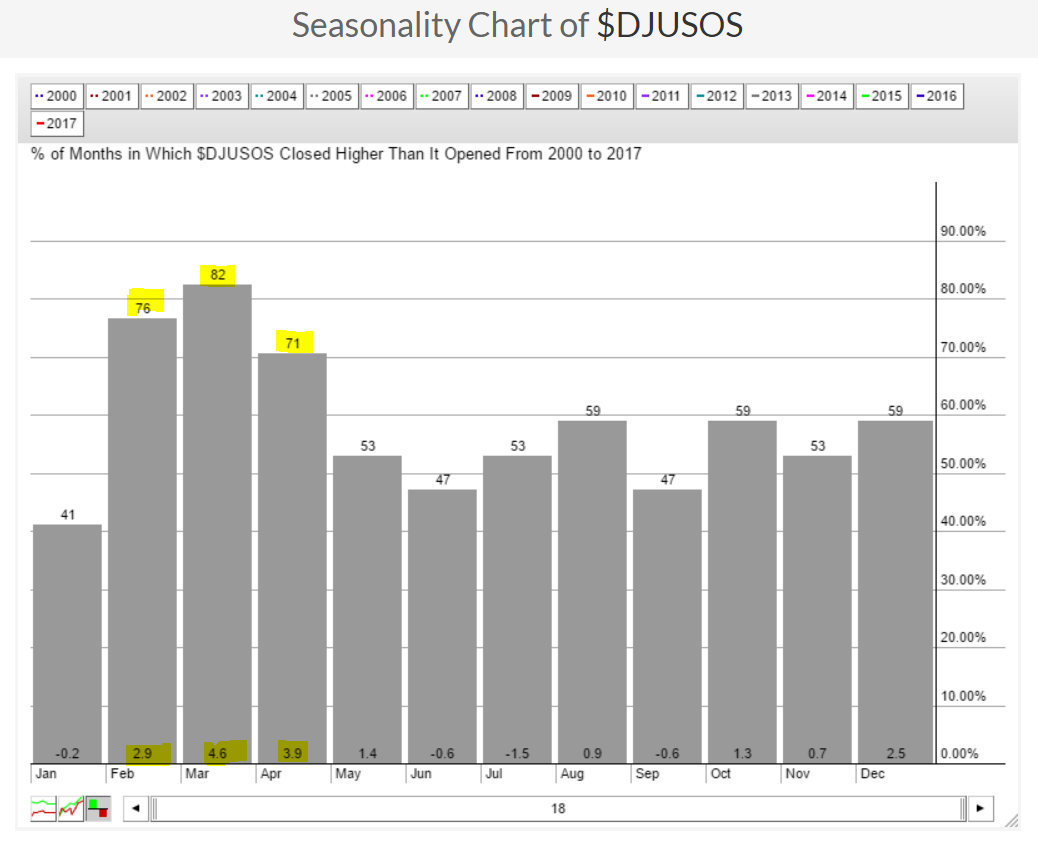Market Recap for Wednesday, January 25, 2017
The Dow Jones kept searching for a catalyst to finally break that psychological 20000 barrier and it came in the form of a one-two punch from transports ($TRAN, +1.43%) and financials (XLF, +1.67%) that left no doubt about the strength of Wednesday's rally. Railroads ($DJUSRR) were particularly strong, rising more than 2% on the session and nearing a major long-term price resistance level. The DJUSRR closed at 1542 while the 1600 level is a very big deal technically as you can see below:
 Should the DJUSRR reach 1600 and stall, recognize that a pullback to test the rising 20 week EMA would constitute a handle and complete the cup with handle pattern. A later breakout above 1600 would then measure to 2300 or so, a very bullish pattern indeed.
Should the DJUSRR reach 1600 and stall, recognize that a pullback to test the rising 20 week EMA would constitute a handle and complete the cup with handle pattern. A later breakout above 1600 would then measure to 2300 or so, a very bullish pattern indeed.
Financials rose on Wednesday because of solid earnings and a rising 10 year treasury yield ($TNX). The TNX surged another five basis points and closed at 2.52% - its highest close in a month and approaching very important yield resistance near 2.60%. Another breakout in the yield would likely ignite another fire under banks ($DJUSBK) and life insurance ($DJUSIL), which yesterday rose 2.04% and 1.75%, respectively, on the heels of the TNX spike.
Pre-Market Action
Asian markets caught fire last night with the Tokyo Nikkei ($NIKK) and the Hong Kong Hang Seng ($HSI) rising by 1.81% and 1.41%, respectively. European shares are also rising this morning, but the gains are much more subdued. Still, global strength is apparent and U.S. stocks are looking to extend their rally after the Dow Jones finally broke above the 20000 barrier. Dow Jones futures are up 15 points with a little more than 30 minutes remaining to the opening bell.
The 10 year treasury yield ($TNX) is flat this morning while crude oil prices ($WTIC) have climbed back over $53 per barrel.
Current Outlook
The Volatility Index ($VIX) is extremely complacent with yesterday's close of 10.81 among the lowest closes we've seen since this bull market began in March 2009. Many will argue that extreme complacency will mark key market tops. I totally disagree. Normally, the VIX rises before the last market top in a bull market. The last two bear markets began (final S&P 500 price high) with VIX readings above 16-17 and we never saw VIX readings below that 16-17 level throughout the entire bear market. Bear markets require elevated fear levels to get started and currently we're showing none of that. Trade this market as you would any bull market - for now. For me, that means trading exclusively on the long side in areas of the market that do not have momentum issues. Take a look at the VIX over the past 10 years:
 At the far right of the above chart, you can see that the VIX is currently below 11. Now go back to the left side of the chart and check out that vertical red line. That marked the October 2007 high on the S&P 500. See what happened to the VIX just prior to that market top? It began rising, showing that traders were anticipating more volatility in market ahead. That rising level of fear is necessary to trigger more impulsive selling and it's those impulsive selling episodes that fuel a bear market.
At the far right of the above chart, you can see that the VIX is currently below 11. Now go back to the left side of the chart and check out that vertical red line. That marked the October 2007 high on the S&P 500. See what happened to the VIX just prior to that market top? It began rising, showing that traders were anticipating more volatility in market ahead. That rising level of fear is necessary to trigger more impulsive selling and it's those impulsive selling episodes that fuel a bear market.
I believe we're heading higher in 2017.
Sector/Industry Watch
The Dow Jones U.S. Heavy Construction Index ($DJUSHV) has gained 10% off its low from Monday. I had written about this group showing signs of slowing price momentum two weeks ago and provided two key areas of support during any unwinding of the momentum issue. Check out the MACD centerline reset and the 50 day SMA test (pink circles), along with the successful test of the first price support level:
 Technical signs don't always work out this perfectly, but the beauty of using technical analysis is that it helps to mitigate risk by patiently awaiting tests of key support levels and/or moving averages.
Technical signs don't always work out this perfectly, but the beauty of using technical analysis is that it helps to mitigate risk by patiently awaiting tests of key support levels and/or moving averages.
Historical Tendencies
Energy (XLE) tends to perform well from February through April - at least from a seasonal perspective. Within that sector, the Dow Jones U.S. Exploration & Production Index ($DJUSOS) starts to pick up a head of steam in February and it lasts for a few months thereafter. Check this out:
 That's a lot of seasonal strength upcoming based on the past 18 years of history.
That's a lot of seasonal strength upcoming based on the past 18 years of history.
Key Earnings Reports
(actual vs. estimate):
ADS: 4.45 vs 4.41
BHI: (.30) vs (.12)
BIIB: 5.04 vs 4.97
BMY: .63 vs .66
BX: .68 vs .64
CAT: .83 vs .65
CELG: 1.41 vs 1.43
CMCSA: .89 vs .87
DGX: 1.31 vs 1.27
DOV: .71 vs .84
DOW: .99 vs .88
ERIC: .07 vs .11
F: .30 vs .36
LEA: 3.80 vs 3.40
LLL: 2.38 vs 2.12
LUV: .74 vs .69
MJN: .78 vs .83
NOC: 2.66 vs 2.49
POT: .07 vs .09
PX: 1.41 vs 1.41
RTN: 1.88 vs 1.86
SWK: 1.71 vs 1.68
TROW: 1.21 vs 1.41
WHR: 4.33 vs 4.42
(reports after close, estimate provided):
BCR: 2.73
FLEX: .30
GOOGL: 7.65
INTC: .75
JNPR: .52
KLAC: 1.41
MSFT: .79
PYPL: .34
SBUX: .52
VMW: 1.08
Key Economic Reports
Initial jobless claims released at 8:30am EST: 259,000 (actual) vs. 246,000 (estimate)
December new home sales to be released at 10:00am EST: 593,000 (estimate)
December leading indicators to be released at 10:00am EST: +0.4% (estimate)
Happy trading!
Tom
